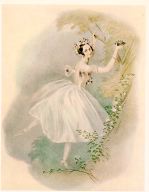 Curtain
Call
Curtain
Call
Ballet costumes duplicated the fashions of the early decades of the nineteenth century and the introduction of lighter weight fabrics as well as the leveling of footwear allowed for new techniques to be achieved in the dance world. What is significant is that the female fashions that emerged during this period continued in the ballet long after they had ceased being fashionable in society (Chazin-Bennahum 1997). Becoming the prototype for the “uniform” of the classical ballet dancer (Beaumont 1946), these costumes embodied the ideals of femininity that emerged during the Romantic Period and persisted in the ballet: delicacy, fragility and the otherworldly. Danseuses continued to wear costumes made out of fabrics such as muslin, don flesh-coloured tights, and, most significantly, utilize flat-soled shoe, although they would soon challenge the horizontality of this footwear.